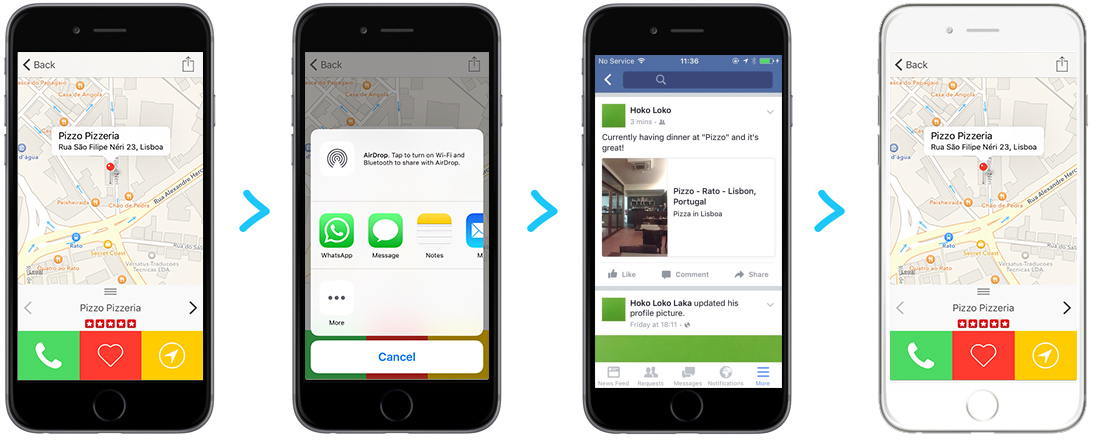Share on Social Networks
Let your users share your app’s content on social media like Facebook and Twitter and use smart links to drive traffic back into your app.

In the following sections we are going to learn how to share smart links using the operating system’s native share controllers.
Step 1: Sharing on social media
In this example, our app is a restaurant booking application where users can share with their friends where they are enjoying a nice meal. Share is done by using a smart link that redirects users to that specific restaurant inside the app.
Let’s start by creating a mobile deep link for this item using the Deeplink.deeplink method.
This is necessary so the app knows what to do when some other user opens the app through the link.
Next, we are going to encapsulate the deeplink inside a smart
link using the generateSmartlink function.
Finally, we are going to share the post using Android Intent.ACTION_SEND.
Thus, the user can pick the best Social Network app. Let’s have a look at the code needed
to generate and share the smart link:
private void setupShareButton() {
// R.id.shareButton would be the ID you would give to that button
mShareButton = (Button) findViewById(R.id.shareButton);
// Add a click event listener to generate smart links
mShareButton.setOnClickListener(new View.OnClickListener() {
@Override
public void onClick(View v) {
HashMap routeParameters = new HashMap();
routeParameters.put("restaurant_id", Integer.toString(mRestaurant.getId()));
Deeplink restaurantDeeplink = Deeplink.deeplink("restaurant/:restaurant_id", routeParameters);
// Generate the smart link based on a deep link
Hoko.deeplinking().generateSmartlink(restaurantDeeplink, new LinkGenerationListener() {
@Override
public void onLinkGenerated(String smartlink) {
// Build the message together with the smart link
String shareText = "Currently having dinner at " + mRestaurant.getName() + " and it's great! " + smartlink;
Intent shareIntent = new Intent(Intent.ACTION_SEND);
shareIntent.setType("text/plain");
shareIntent.putExtra(Intent.EXTRA_TEXT, shareText);
// And... it's ready! Let's present the share popup to the user
startActivity(Intent.createChooser(shareIntent, "Share"));
}
@Override
public void onError(Exception e) {
System.out.println(e.getMessage());
}
});
}
});
}If the item shared through your app is also available on your website, we will automatically
parse your website and attach any metatag available to the smart link, like og:image,
og:description, image or any other present.
This way, when you include smart links in social media
posts you can have extra data like thumbnails and descriptions. Make sure you have a Web
platform and a Template configured. Check the documentation about
templates to know more.
Step 2: Handling smart links inside your app
When the user opens your app through a smart link, it’s up to you to present the appropriate view within your app. You also have to define what are the deep linking routes that your app is going to support.
Route mapping with annotations
One way to start mapping your routes with HOKO is to use our simple and straightforward
annotations at the beginning of your Activities and Fragments.
@DeeplinkRoute("restaurant/:restaurant_id")
public class ProductActivity extends Activity {
@DeeplinkRouteParameter("product_id")
private int mProductId;
@Override
public void onCreate(Bundle savedInstanceState) {
super.onCreate(savedInstanceState);
mProductId = getIntent().getIntExtra("product_id", 0);
// Do something when deeplink is opened
}
}Route mapping without annotations
If you wish to manage the deep linking mapping logic manually, all you have to do is to map each
route with Hoko.deeplinking().mapRoute() and a DeeplinkCallback callback object.
Hoko.deeplinking().mapRoute("restaurant/:restaurant_id", new DeeplinkCallback() {
@Override
public void deeplinkOpened(Deeplink deeplink) {
String productId = deeplink.getRouteParameters().get("product_id");
// Start the activity to show the item
}
})You can find more information about Route Mapping in the documentation.
More information
Need to know more about this? You can find more information in the following pages:
Check our frequently asked questions or send us a message if you can’t find what you are looking for. We’re always glad to hear from you and answer all your questions.
